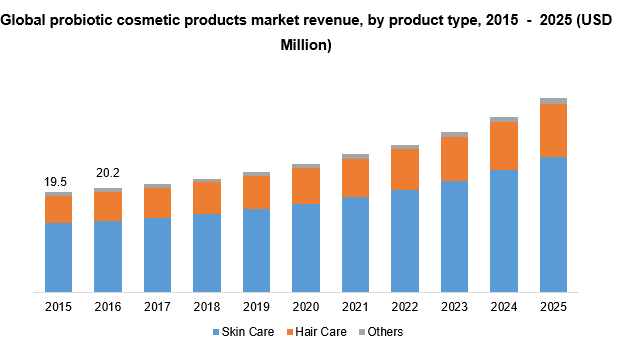
Probiotic Cosmetic Products Market Size and Forecast, By Product Type (Skin Care, Hair Care), By Distribution Channel (Hypermarkets & supermarkets, Specialty stores, Drug stores, Online) and Trend Analysis, 2019 - 2025
- Published: March, 2019
- Format: Electronic (PDF)
- Number of pages: 65
- Industry: Personal Care & Cosmetics
Industry Insights
The global probiotic cosmetic products market was valued at USD 21.0 million in 2017. The gaining popularity of probiotics as a key functional ingredient which is effective against various skin concerns such as acne, wrinkle, and blemishes is expected to remain one of the favourable factors over the coming years.
Over the past few years, the penetration of probiotics in the cosmetics segment has increased as consumers are increasingly patronising cosmetics with natural ingredients as opposed to products with chemicals. Growing awareness about their clinical evidences and efficacy has also added to the growth.

Packaging remains a key concern for companies as keeping probiotics alive through the supply chain is a challenge as these products have to be kept in aseptic conditions and have short shelf life. These cosmetics also command high price which tends to limit their mass scale adoption.
Segmentation by Product Type
• Skin care
• Hair care
• Others
In 2017, skin care products dominated the market with more than 65.0% share. The increasing adoption of natural cosmetics as opposed to their synthetic counterparts has spurred demand growth. Among the various consumer groups, millennials are the key demand generators as they continue to incline towards organic personal care products including probiotic cosmetic.
Hair care products is expected to grow at a CAGR of more than 7.0% from 2017 to 2025. Demand is expected to remain strong as consumers continually seek hair care products with pure organics. In the coming years, product innovation and new product launches in the hair care market are expected to drive demand.
Segmentation by Distribution Channel
• Hypermarkets & supermarkets
• Specialty stores
• Drug stores
• Online channel
• Others
Hypermarkets & supermarkets was the largest distribution channel accounting for more than 35.0% of the market in 2017. These stores stock a wide variety of cosmetics from various brands across different price points and are highly frequented by customers. Some of the key stores in the hypermarkets & supermarkets channel include Walmart and Carrefour.
Online retailing is expected to be the fastest growing channel in the coming years. The penetration of these stores is increasing as they provide convenience and offer a wide array of products sourced from various manufacturers. Vendors such as Amazon and Alibaba are among the key players active in the online space.
In the coming years, increasing penetration of the internet and smartphones coupled with the increasing awareness about probiotics cosmetics is expected to add to the prevailing demand. Penetration of the online channel is expected in key consumer markets of Asia Pacific, where countries such as India and China are expected to contribute considerably to the demand.
Segmentation by Region
• North America
• U.S.
• Europe
• UK
• Asia Pacific
• China
• India
• Middle East & Africa
• Central & South America
• Brazil
North America was the largest market accounting for more than 35.0% of the share in 2017. U.S. is a key country in the region where demand has grown considerably in the probiotic skin care and hair care categories. In the coming years, the market is expected to be more regulated as the FDA is mulling a legal definition of probiotics.
Asia Pacific is expected to be a fastest growing market at a CAGR of more than 8.0% from 2017 to 2025. Much of the growth is expected from countries such as China and India, which have a huge consumer base. Increasing awareness and adoption of organic cosmetics at large is expected to drive demand. New products are expected to make inroads to these countries in the near future.
Competitive Landscape
The global probiotic cosmetic products market is highly competitive and is marked by the presence of well-established companies such as L'Oréa and Unilever. In the coming years, companies are expected to streamline their production process in the light of an expected FDA regulation around the legal definition of probiotic cosmetics.
Companies are expected to focus on product innovation and launches in the coming years. To this end, exclusive products for both men and women are expected. Manufacturers will also focus on expanding their reach to growing consumer markets such as China and India.
Focus will also be on innovating effective packaging solution as keeping probiotics alive through the distribution channel remains a challenge. For instance, ESSE, the South Africa-based company, uses airless glass packaging for its probiotic serum.
Some of the key manufacturers include ESSE SKINCARE, L'Oréal, Unilever, Estée Lauder Companies Inc., Aurelia Skincare Ltd., EMINENCE ORGANIC SKIN CARE, TULA Life, INC, LaFlore Probiotic Skincare, and THE BODY DELI.

Choose License Type
- World's largest premium report database
- Transparent pre & post sale customer engagement model
- Unparalleled flexibility in terms of rendering services
- Safe & secure web experience
- 24*5 Research support service
